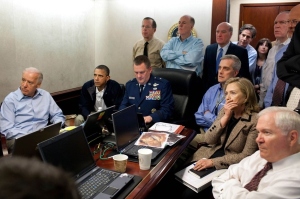
Members of the National Security Council react to an update they received about the mission against Osama Bin Ladin on May 1, 2011.
(Credit: HANDOUT / Reuters)
Today you can take a trip to the other side of the world or even outer space by clicking a button. You can catch a glimpse of our nation’s leaders gathered in a closed door meeting to watch a top secret operation unfold, or view snap shots of countries shrouded in secrecy like North Korea all on your smart phone.
News is becoming more and more visual. Seeing has always been believing and now we can see places, breaking news and moments from history in a matter of seconds thanks to ever-improving technology and the internet.
While we love words sometimes an image really is worth a thousand of them. It’s no wonder Facebook didn’t bat an eye at spending $1 billion to acquire Instagram. This first of its kind purchase for Facebook was done mainly to allow the social network to produce the best photo sharing experience possible. Photos on Facebook generate 53 percent more “likes” then other posts.
The more we see and the more we share comes with its fair share of controversy. A recent example of this is the commercial Coca-Cola debuted during this year’s Super Bowl. The minute long #AmericaisBeautiful commercial featured a diverse array of Americans doing every day activities with Coca-Cola products subtly placed throughout. The only words used in the commercial were the lyrics to the classic, patriotic song “America the Beautiful.” It was sung by young women in eight different languages. These few words paired with a variety of scenes of Americans from different backgrounds, cultures, races, religions and sexual orientations produced powerful reactions from viewers. While it may have caused some to shed a tear and run out to stock up on more Coke, it sparked outrage across the internet from English-only proponents calling on people to boycott the company. Sure the controversy was mainly aimed at “America the Beautiful” being sung in languages other than English, but we can’t help but wonder if the reactions and controversy would remain if the song was taken away? After all, the images used reinforced the message and the put a face to Americans who are multilingual or non-native English speakers.

The young girl pulling petals off a flower depicted in Lyndon B. Johnson’s 1964 “Peace Little Girl (Daisy)” Presidential campaign ad.
(Credit: NBC Universal)
While not everyone may like what they see, there is no doubt that images are powerful. Images have helped topple regimes and sway elections. An example of this power is the ad Lyndon B. Johnson used in his 1964 Presidential campaign against Barry Goldwater. The ad known as “Peace Little Girl (Daisy)” features a young girl counting the petals she picks off a flower. The counting is then taken over by a ominous voice signaling the detonation of a nuclear bomb followed by the image of a mushroom cloud. While this campaign commercial ran only once as paid advertisement it was successful in painting Goldwater as warmonger eager to use nuclear force to win the Vietnam War and helped secure the election for Johnson.
Over the next couple of months we will explore how the 4th Estate is becoming more visual. This month we plan to share some of our favorite iconic and even infamous images from history. From sketches and illustrations used before photographs to the pictures that made us stop and think to the social media applications that allow us to participate and share our own images. Next month we’ll deepen this exploration and feature online publications and social media applications that are using images to report the news. We invite you to share your favorite images with us and the stories, feelings and words that you associate with them.
Liz Faris, Account Manager
Collaborative Services


Recent Comments